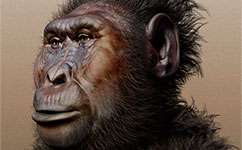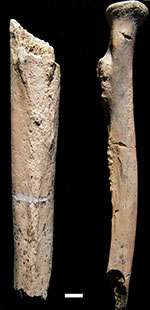Biology of early human relative uncovered

The partial skeleton of an ancient hominin has been uncovered for the first time in Tanzania, giving a new insight into the species' biology, say scientists.
The accidental discovery was made last year when, during an archaeological excavation, scientists uncovered pieces of skull, teeth and limb bones.
The bones belong to an early hominin, called Paranthropus boisei, which lived 1.34 million years ago in Eastern Africa and shares an ancestor with humans. Archaeologists had only ever discovered parts of skulls belonging to this species, so until now had no real evidence of its size or how it was adapted to its environment.
'The Paranthropus species lived at a time when the climate of eastern Africa was changing, moving from wet savannahs populated with many trees to the grassland we see today. Creatures that lived in the trees began to disappear as their resources died,' explains Dr Manuel Domínguez-Rodrigo, of the Museo de los Orígenes in Madrid, Spain, lead author on the paper published in Plos ONE.
To thrive during these changes many species were adapted to cope in a huge variety of environments, and with a widely varied diet.

The team uncovered an exceptionally large humerus bone which suggests Paranthropus had large forearms designed for tree-climbing. But its large molar teeth suggest it would also have spent a lot more time on the ground than some of its tree-dwelling ancestors.
'The molar teeth are much larger than the teeth we see in humans today; it shows that they would put anything and everything into their mouths. They are also the only hominin we've ever seen that survived on eating grass,' Domínguez-Rodrigo continues.
The scientists determined that the animal they discovered was a male, in the prime of fitness by studying the well-preserved femur and humerus bones and teeth.
'It was exciting to see for the first time how big this Paranthropus was,' explains Domínguez-Rodrigo. 'This animal weighed about 60 kilograms we think – significantly heavier than estimates we have for another specimen, which we think may be a female Paranthropus.'
'The femur and humerus we found also showed similarities with Homo erectus, which we think may have been around at the same time as Paranthropus,' he continues.
Homo erectus may have evolved from the same ancestor as Paranthropus. But while the homo erectus evolved into modern day humans, Paranthropus became extinct.
More information: Domínguez-Rodrigo M, Pickering TR, Baquedano E, Mabulla A, Mark DF, et al. (2013). "First Partial Skeleton of a 1.34-Million-Year-Old Paranthropus boisei from Bed II, Olduvai Gorge, Tanzania." PLoS ONE 8(12): e80347. DOI: 10.1371/journal.pone.0080347
Journal information: PLoS ONE
Provided by PlanetEarth Online
This story is republished courtesy of Planet Earth online, a free, companion website to the award-winning magazine Planet Earth published and funded by the Natural Environment Research Council (NERC).



















